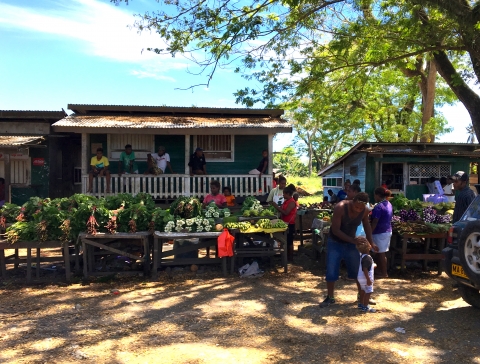August Visit to Solomon Islands: Financial Inclusion and Consumer Protection

There is no shortage of entrepreneurial spirit on display in Solomon Islands. The main road to the capital city, Honiara, is lined with tiny huts and houses, each fronted by a stall or table, selling eggplants, greens, betel nuts and chillis. Yet the majority of adults in this country have never had a bank account, let alone the loans, insurance and other financial services necessary to grow a roadside stall into a profitable business.
In August, the UNSW Digital Financial Services Diagnostic Team (UNSW DFS Diagnostic Team) visited Honiara for the second time this year on a project designed to assist in closing this "gap" in the provision of financial services, and increase financial inclusion.
Since 2012, the introduction of digital financial services in Solomon Islands has greatly increased access to financial services, but actual usage rates for these services remain low.[1] In partnership with the UNCDF, the UNSW DFS Diagnostic Team has developed a Regulatory Diagnostic Toolkit (RDT), which essentially aids regulators, like the Central Bank of Solomon Islands, to make a structured assessment of the regulatory framework relevant to the growth, support and safe delivery of digital financial services. It identifies gaps in, and barriers created by, the relevant regulatory infrastructure which may negatively impact the adoption and use of these services.
Solomon Islands Quick Facts:
- There are over 70 dialects spoken in the country by people who live on 90 of the country's 900+ islands.[2]
- Around 75% of the population lives in rural areas.[3]
- Those without a bank account live an average of 6 hours from the nearest branch and it can reportedly cost USD19 to reach the branch.[4]
- 75% of domestic remittances (money transferred within the country) are made by friends and relatives physically carrying cash.[5]
Despite usage rates being low, progress has been made in the provision of financial services in Solomon Islands, with the Central Bank exceeding its goal of providing access to financial services for 70,000 previously ‘unbanked’ people as part of its 2011-2015 National Financial Inclusion Strategy (NFIS).[6] The Central Bank is implementing its second NFIS, including a focus on actual usage, and there is a major overhaul of legislation in the financial service sector in progress, with almost every significant piece of legislation being reviewed or amended.
On their first visit in May, the UNSW DFS Diagnostic Team held interviews with the Central Bank and government and industry stakeholders, and applied the RDT to analyse the current state of affairs for the regulation of digital financial services in the country. This analysis included the regulatory architecture as a whole, protection of funds, the use of agents, consumer protection, data privacy, anti-money laundering / counter the financing of terrorism, and building an ‘ecosystem’ which supports sustainable digital financial services.
During last month’s follow-up visit, the Team presented the key findings from this research to the Central Bank, to get feedback on the report and its recommendations. The team also met with other representatives from government and industry, including commercial banks, agents and telecommunications companies.
A central message from all quarters on this visit was that a well-balanced approach to consumer protection lies at the heart of optimal growth in and adoption of digital financial services. An effective consumer protection policy should balance the need to protect vulnerable first-time consumers of financial services and build consumer trust and confidence, with the need to provide a regulatory environment which does not unnecessarily tax innovation and growth by providers.
Having returned to Australia, the Team is assisting the Central Bank to address priority matters relevant to its financial inclusion policy. Solomon Islands is the first country in which the RDT has been used to analyse the regulatory framework in this way.
Authored by Dr Katharine Kemp
Photo credit also goes to Katharine Kemp
[1] ‘Solomon Islands National Financial Inclusion Strategy 2016-2020’ (Report, 2016).
[2] Pacific Region Infrastructure Facility, ‘Economic and Social Impact of ICT in the Pacific’ (Report, June 2015) 120; Ethnologue: Languages of the World, Solomon Islands <http://www.ethnologue.com/country/SB>.
[3] United States Central Intelligence Agency, ‘Solomon Islands’ (22 December 2015) The World Factbook <https://www.cia.gov/library/publications/the-world-factbook/geos/bp.html>.
[4] Central Bank of Solomon Islands (CBSI), ‘Financial Services Demand Side Survey Solomon Islands’ (Report, 2015) 1, 7.
[5] CBSI, ‘Financial Services Demand Side Survey Solomon Islands’ (Report, 2015) 13.
[6] Alliance for Financial Inclusion, ‘Celebrating Five Years of Advancing Global Financial Inclusion: 2016 Maya Declaration Progress Report’ (August 2016) 12.

